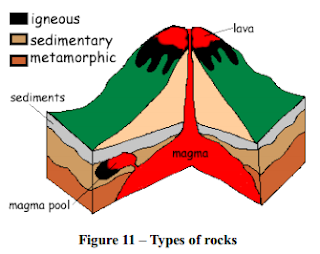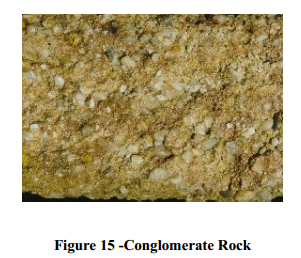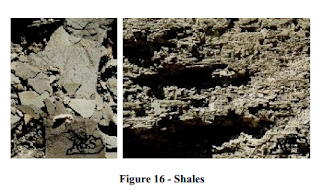Just as any person can be put into one of two main categories of human being, all
rocks can be put into one of three fundamentally different types of rocks. They are
igneous, sedimentary and metamorphic rocks:
Igneous rocks are crystalline solids, which form directly from the cooling of magma.
This is an exothermic process (it loses heat) and involves a phase change from the
liquid to the solid state.
Each mineral forms a characteristic type of crystal. For example, the well known igneous
rock, Granite, is composed of three main minerals, Quartz, Mica and Feldspar, all of
which look different and can be clearly seen in a sample.
The size of the crystals is usually determined by the speed at which the molten rock
material cools. Quick cooling produces small crystals, slow cooling produces larger
crystals.
The earth is made of igneous rock - at least at the surface where our planet is exposed
to the coldness of space. Igneous rocks are given names based upon two things:
composition (what they are made of) and texture (how big the crystals are).
Magmas occur at depth in the crust, and are said to exist in "magma chambers," a
rather loose term indicating an area where the temperature is great enough to melt the
rock, and the pressure is low enough to allow the material to expand and exist in the
liquid state. Many different types of igneous rocks can be produced. The key factors
to use in determining which rock you have are the rock's texture and composition.
Texture
Texture relates to how large the individual mineral grains are in the final, solid rock. In
most cases, the resulting grain size depends on how quickly the magma cooled. In
general, the slower the cooling, the larger the crystals in the final rock. Because of this,
we assume that coarse grained igneous rocks are "intrusive," in that they cooled at
depth in the crust where they were insulated by layers of rock and sediment. Fine
grained rocks are called "extrusive" and are generally produced through volcanic
eruptions.
Grain size can vary greatly, from extremely coarse grained rocks with crystals the size
of your fist, down to glassy material which cooled so quickly that there are no mineral
grains at all. Coarse grain varieties (with mineral grains large enough to see without a
magnifying glass) are called phaneritic. Granite and gabbro are examples of phaneritic
igneous rocks. Fine grained rocks, where the individual grains are too small to see, are
called aphanitic. Basalt is an example. The most common glassy rock is obsidian.
Obviously, there are innumerable intermediate stages to confuse the issue.
Composition
The other factor is composition: the elements in the magma directly affect which
minerals are formed when the magma cools. Again, we will describe the extremes, but
there are countless intermediate compositions.
The composition of igneous magmas is directly related to where the magma is
formed. Magmas associated with crustal spreading are generally mafic, and produce
basalt if the magma erupts at the surface, or gabbro if the magma never makes it out
of the magma chamber. It is important to remember that basalt and gabbro are two
different rocks based purely on textural differences - they are compositionally the
same. Intermediate and felsic magmas are associated with crustal compression and
subduction. In these areas, rock and sediment from the surface is subducted back into
the crust, where it re-melts. This allows the differentiation process to continue, and
the resulting magma is enriched in the lighter elements. Intermediate magmas
produce diorite (intrusive) and andesite (extrusive). Felsic magmas, the final purified
result of the differentiation process, lead to the formation of granite (intrusive) or
rhyolite (extrusive).
Sedimentary Rocks
Sedimentary rocks are formed at the surface of the Earth, either in water or on land. They
are layered accumulations of sediments-fragments of rocks, minerals, or animal or plant
material. Temperatures and pressures are low at the Earth's surface, and sedimentary
rocks show this fact by their appearance and the minerals they contain.
Most sedimentary rocks become cemented together by minerals and chemicals or are held
together by electrical attraction; some, however, remain loose and unconsolidated. The
layers are normally parallel or nearly parallel to the Earth's surface; if they are at high
angles to the surface or are twisted or broken, some kind of Earth movement has occurred
since the rock was formed. Sedimentary rocks are forming around us all the time.
Sand and gravel on beaches or in river bars, look like the sandstone and conglomerate
they will become. Compacted and dried mud flats harden into shale. Scuba divers who
have seen mud and shells settling on the floors of lagoons find it easy to understand how
sedimentary rocks form. Sedimentary rocks are called secondary, because they are often
the result of the accumulation of small pieces broken off of pre-existing rocks.
There are three main types of sedimentary rocks:
Clastic sedimentary rocks:
Clastic sedimentary rocks are accumulations of clasts: little pieces of broken up rock
which have piled up and been "lithified" by compaction and cementation.
Sandstone
Sandstone is composed of mineral grains (commonly quartz) cemented together by silica,
iron oxide, or calcium carbonate. Sandstones are typically white, gray, brown, or red. The
red and brown sandstone is colored by iron oxide impurities. Most sandstones feel gritty,
and some are easily crushed (friable) and break up to form sand. Sandstones have pore
spaces between each grain of sand; this property, called porosity, makes them good
reservoirs for oil and natural gas. Sandstones are very resistant to erosion and form bluffs,
cliffs, ridges, rapids, arches, and waterfalls.
Conglomerate
Conglomerate is a sedimentary rock usually composed of rounded quartz pebbles,
cobbles, and boulders surrounded by a matrix of sand and finer material, and cemented
with silica, iron oxide, or calcium carbonate. The rock fragments are rounded from being
rolled along a stream bed or a beach during transportation. If the fragments embedded in
the matrix are angular instead of rounded, the rock is called a breccia (pronounced
BRECH-i-a).
Shales
Shale is the most abundant of all sedimentary rocks. It is composed primarily of soft clay
minerals, but may include variable amounts of organic matter, calcareous material, and
quartz grains. Shale may be any color, but is generally greenish gray to grayish black. It
is relatively soft and has a smooth, greasy feel when freshly exposed, but is hard and
brittle when dry. Most shales split into thin plates or sheets and are termed fissile, but
others are massive (nonfissile) and break into irregular blocks. Shales weather very easily
to form mud and clay.
Clays
The term "clay" is applied to various earthy materials composed dominantly of hydrous
aluminum magnesium silicate minerals. The most familiar characteristic of clay is
plasticity or the ability of moist clay to be fashioned into a desired shape. The physical
properties of a clay are plasticity, strength, and refractoriness. Plasticity enables the clay
to be molded; strength permits it to be handled during the forming, drying, and burning
processes; and refractoriness permits it to be burned into a hard body of permanent form
Bentonite
Bentonite is a soft, low-specific-gravity, expandable clay. It is altered volcanic ash and is
found in central Kentucky in beds up to 3 feet thick near the top of the Tyrone Limestone.
Drillers have labeled these bentonite beds the Mud Cave and Pencil Cave. Because of its
peculiar property of expanding when wet, bentonite is effective as a water sealer,
especially to prevent pond leakage, and is also used in rotary drilling muds to prevent
contaminating formations with drilling fluid.
Chemical sedimentary rocks:
Mny of these form when standing water evaporates, leaving dissolved minerals behind.
These are very common in arid lands, where seasonal "playa lakes" occur in closed
depressions. Thick deposits of salt and gypsum can form due to repeated flooding and
evaporation over long periods of time. Other chemical sedimentary rocks include
sedimentary iron ores, evaporites such as rock salt (Halite), and to some extent flint,
limestone and chert.
Organic sedimentary rocks
Any accumulation of sedimentary debris caused by organic processes. Many animals
use calcium for shells, bones, and teeth. These bits of calcium can pile up on the
seafloor and accumulate into a thick enough layer to form an "organic" sedimentary
rock. These include Limestone, Chalk and Coal.
Clues that may help you recognize a sedimentary rock are...
• It looks like bits of other rocks stuck together.
• It has a gritty feel and bits can be rubbed off it.
• It contains fossils, bits of shell or pebbles.
• There are no, or very few crystals in it.
• All the grains look rounded and worn.
Metamorphic Rocks
The metamorphics get their name from "meta" (change) and "morph" (form). Any
rock can become a metamorphic rock. All that is required is for the rock to be moved
into an environment in which the minerals which make up the rock become unstable
and out of equilibrium with the new environmental conditions.
The process of metamorphism does not melt the rocks, but instead transforms them into
denser, more compact rocks. New minerals are created either by rearrangement of
mineral components or by reactions with fluids that enter the rocks. Some kinds of
metamorphic rocks--granite gneiss and biotite schist are two examples--are strongly
banded or foliated. (Foliated means the parallel arrangement of certain mineral grains that
gives the rock a striped appearance.) Pressure or temperature can even change previously
metamorphosed rocks into new types.
In most cases, this involves burial which leads to a rise in temperature and pressure.
The metamorphic changes in the minerals always move in a direction designed to
restore equilibrium. Common metamorphic rocks include slate, schist, gneiss, and
marble.






No comments:
Post a Comment